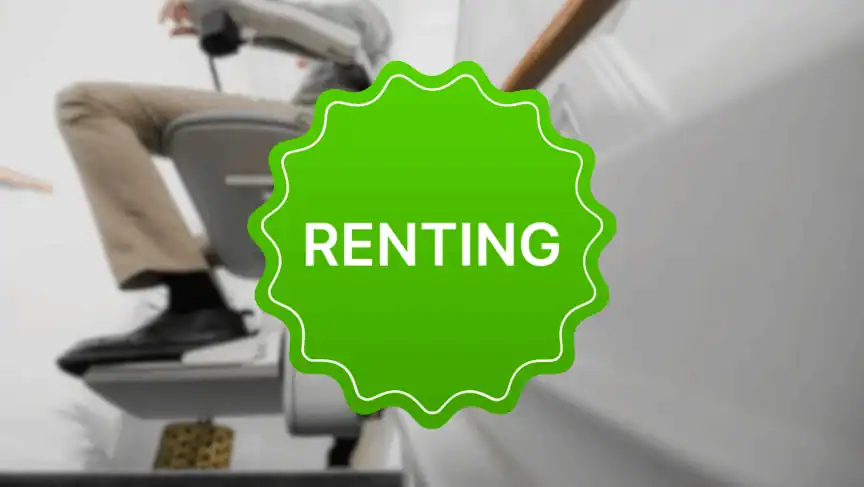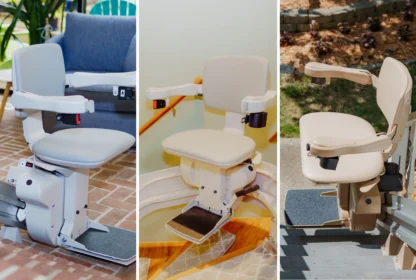
Every year, millions of people in the U.S. go through surgery and for most, there is a stretch of recovery time where getting around isn’t as easy as it used to be. With hip and knee replacements, or even abdominal surgeries, moving around a home and doing daily tasks like walking, bending, or climbing stairs, can become far more difficult.
It’s something so many families face, even if they don’t talk about it much. Maybe a spouse who needs back surgery and now needs help getting up from their favorite chair. Maybe it’s a parent who had a hip replacement and can’t manage the stairs to their bedroom. Or maybe it’s you trying to figure out how to make your home more comfortable while you heal.
Depending on the procedure this recovery period could last weeks, months or sometimes lead to long-term changes in mobility. During this time, adjustments like ramps, stairlifts or knee scooters, can make the experience comfortable, safer, and give more independence.
That is what this guide is all about. We’ll look at some ways to improve the recovery experience and decide if it makes sense to rent or buy.
Homebound After Surgery: Your Guide to Short-Term Mobility Solutions
If you are getting ready for surgery, or helping a loved one through recovery, you’re probably wondering how you can make those everyday tasks and movements easier at home. Simple things like climbing the stairs, getting in and out of bed, or stepping over a doorway can suddenly feel like big hurdles.
You may have seen all the big equipment options and wondered, “Do I really need to buy all of this? Can I just rent this mobility equipment after surgery?” That is a great question and one we hear all of the time at 101 Mobility.
We will walk you through what equipment can help the most after recovery, when it makes sense to rent versus buy, and how 101 Mobility can make the process simple, affordable and stress-free. Think of this as a guide to healing comfortably at home.
Post-Surgery Mobility Needs by Procedure

At 101 Mobility we strive to make finding and getting the right mobility equipment a seamless experience. Every surgery and every recovery looks a little different, but there are some common patterns and tools that make a world of difference during the first few weeks or months at home.
Knee or Hip Replacement
After a knee or hip replacement, it’s normal to feel stiff, sore and unsteady for weeks or months. Stairs will be tricky for a while, so a stairlift or ramp could make getting to all levels of the home easier.
- Stairlifts: After a knee surgery, in a post operative survey “27% of patients felt limited during stair ascent, while an even more significant percentage (65%) felt during stair descent.” A temporary stairlift rental makes getting up and down stairs a breeze. Simply sit down, press a button, and gently glide safely to the landing. No strain, pain or risk of falling.
- Wheelchair Ramps: According to Johns Hopkins, hip replacement takes an average of two to four weeks to heal, but your doctor and team will have a more precise timeframe based on your situation. A temporary wheelchair ramp can be especially helpful during this time, especially at the front door, garage, or anywhere outside that has a tricky set of stairs. When walking, using a walker or wheelchair the ramp allows for smooth and easy access in any weather.
Foot or Ankle Surgery
If foot or ankle surgery is in the cards, you likely won’t be able to put weight on that leg for several weeks. Crutches work, but they get old fast and they can be exhausting to use for hours each day. On top of that it makes stairs a huge risk, so you have some options. A knee scooter will allow you to get around easily and stairlifts or wheelchair ramps can make stairs a breeze.
- Knee Scooter: Whenever a procedure requires a cast or boot, which most foot or ankle surgeries do, it can relieve a lot of weight and strain to use an alternative to crutches. Renting a knee scooter can be a game changer. It’s comfortable, stabilizing and easy to use so you can get around without it feeling like a workout.
- Stairlifts: While you may be able to climb the stairs safely without a lift after an ankle surgery, a temporary stairlift ensures safe access to all areas of your home without the same level of strain and concentration. Just push a button and be safely whisked to the end of your staircase.
- Wheelchair Ramps: During the booted phase of recovery, a ramp is usually a safer option for outdoor stairs or entryways keeping them manageable with a wheelchair, crutches or a knee scooter.
Back Surgery
Today, back surgeries are performed 2.4 times more than 15 years ago according to some studies evaluated by NIH. While technology has advanced and recovery is more efficient than ever, it still takes time and it can be painful or difficult to stand up from sitting, lying down, or climbing stairs. There are a few options that will make it easier including a stairlift, lift chair and patient lift for those extensive surgeries.
- Stairlifts: Compression of the nerves due to surgical swelling and the need to avoid straining the back during the delicate recovery period makes a temporary stairlift with an easy button push to get you from one landing to another an ideal choice for the early weeks of recovery.
- Lift Chair: A spinal surgery can have a multi-month recovery period and something as common as getting in and out of a chair can be difficult. A lift chair is a recliner chair that gently lifts you into a standing position and can really make those first few weeks significantly more restful.
- Patient Lifts: If a longer recovery period is needed, a patient lift can help move someone from bed to chair and back making it easier for the patient and caregiver.
General or Abdominal Surgery
An abdominal surgery causes a lot of fatigue and the need for a gradual return to regular activity levels. This is because many core muscles provide critical dynamic stabilization for the lumbar spine. Generally the recovery period for an abdominal surgery is four to eight weeks, but could be longer depending on your particular circumstances. Sometimes you might not even be in pain, just tired from healing. A stairlift and scooters can make that return to normal feel a little faster.
- Stairlifts: Climbing stairs can be taxing and exhausting, especially with temporarily compromised core muscles. A temporary stairlift will move you between floors with the press of a button so you can access the whole house without extra stress.
- Scooters or Power Chairs: If you have a big home or just tire very easily a power chair or scooter can make moving around a lot easier especially in the first few weeks.
Renting Mobility Equipment After Surgery: The Practical Choice

If recovery is only expected to last a few weeks or months renting mobility equipment is the most practical and budget-friendly choice.
Pros of Renting:
- It’s affordable: You could save money by renting rather than buying depending on the length of use and the particular equipment used. For example, a wheelchair ramp rental might cost a few hundred dollars for the whole month instead of thousands to buy and install a permanent one.
- It’s flexible: Once you’re healed, 101 Mobility will come, take everything down and take it away. No storage, no reselling, no hassle.
- It’s worry-free: Renting means you don’t have to think about repairs or maintenance. If something stops working 101 Mobility will fix or replace it quickly.
- It’s convenient: We deliver and install everything for you. Also, our technicians do this everyday so they will make sure everything is done correctly and safely.
Cons of Renting:
- Renting long-term can add up: If you end up needing equipment for a year or more it might make more sense financially to buy it outright.
- Fewer customization options: Rentals come in standard models and configurations so you can’t personalize it. For example, when renting a stairlift, you can select any of a number of straight lifts, but a curved option is considered a customization because each staircase is unique.
Buying Mobility Equipment: The Long-Term Investment

Sometimes recovery turns into a new way of living. Maybe your surgery brought lasting changes to your mobility, or maybe a loved one is facing a long-term condition that makes stairs or uneven entryways difficult to manage. In those cases, buying mobility equipment can be a wise and empowering decision.
Owning your equipment means you can create a space that truly works for your lifestyle—without deadlines, delivery schedules, or ongoing rental fees. It’s an investment not only in your home, but in your independence, safety, and peace of mind.
Pros of Buying:
- It’s yours for good: If you know you’ll need the equipment long-term, buying saves you from ongoing rental costs.
- You get full control: You own it, use it whenever you want, and don’t have to worry about scheduling or contracts.
- You can customize it: Buying allows you to match your home and your needs—like choosing a stairlift color that blends with your décor or a ramp built exactly to your entryway.
- Long-term value: This equipment is meant to last, so if your personal needs change, you can pass it on to friends or family when and if they need it.
- Service plans: Once you buy, you’ll have access to 101 Mobility maintenance and services plans to keep your equipment working well.
Cons of Buying:
- Upfront cost: While ultimately purchasing will be a lower cost option long-term, there is a substantial upfront cost. For example, a new stairlift will cost a few thousand dollars.
- Maintenance Costs: Once the warranty is up, all repairs, maintenance and care will be your responsibility. That is why most people choose a 101 Mobility service plan to keep things running smoothly without unexpected costs.
Making Your Decision: A Quick Checklist
| Question | Think About | Best Option |
| How long will I need this? | A few weeks or months? | Rent |
| What is my budget? | Want to save money upfront? | Rent |
| Will I need it again later? | Long-term or recurring needs? | Buy |
| Do I want easy installation and removal? | Want someone to handle everything? | Rent |
| Do I want something that matches my home? | Want a custom look? | Buy |
Your Partner in Recovery: Why 101 Mobility is the Best Choice
If you or a loved one are going to recover from surgery at home, we are here to make it simpler.
Not sure if you should rent or buy? No problem. You can get a free consultation where we will help you decide exactly what you need and give you clear, up-front pricing so there are no surprises. Once you have a plan, our knowledgeable local technicians will handle delivery, installation and removal, walking you through how to use everything safely before they leave.
Get a customized recommendation . Contact us today to learn more about our rental and purchase options and to get a free, no-obligation quote



